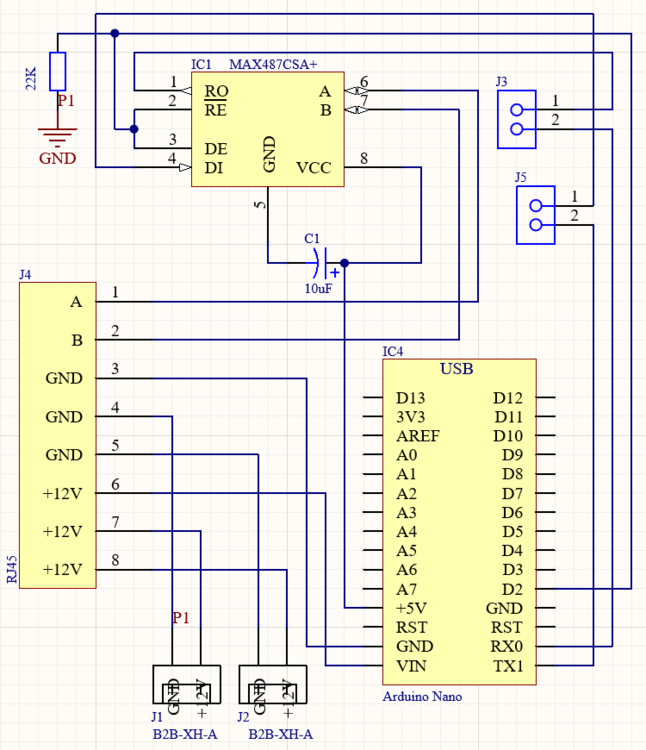-
Posts
36 -
Joined
-
Last visited
About ramzessii
- Birthday 01/26/1979
Personal Information
-
Flight Simulators
P3D, FSX. DCS
-
Location
Southampton, UK
-
Interests
Aviation, photography
-
Occupation
HR Assistant
Recent Profile Visitors
The recent visitors block is disabled and is not being shown to other users.
-
ramzessii started following DCS-BIOS over RS485
-
Hi all, I guess, I've figured it out by reading some of Vinc_Vega's posts. This is my first-ever schematic. Please let me know if it's not right. Thank you. I've also noticed that many PCBs have large copper ground fills - is this necessary and what is the benefit? Can it not be just nets with the rest of the copper being etched away?
-
Hi Hansolo, Thank you for the incredible tutorial. It is ever so valuable, especially for newbies like me. Frankly, it is not just you but many others sharing their knowledge, who also need to be thanked. Question - which connection(s) between the MAX487 and the Arduino Nano on a slave unit has to be broken to allow programming the Arduino via USB? Is it TX, RX or both? I want to put a jumper on my PCB board to make my life easier when/if uploading an Arduino sketch is needed. Once I'm finished designing both the schematic and PCB, I'll upload the photos here. Hopefully, it will inspire someone... or more likely will draw someone's attention to some mistakes I've made Thank you. Regards, Janis
-
Marvellous, thank you Vinc_Vega! I shall try this. I'm yet to find a way how to achieve the same in Fusion 360, but I'm sure that for now, I can stick to Fritzing - after all, it should be easier to learn than Fusion. Kind regards, Janis
-
ramzessii started following Continuous game crash , PCBs from PCBWay , A-10c CDU Tabletop Build and 1 other
-
Good time of the day! I apologise for shifting this topic slightly. I'm trying to build some panels despite having an insignificant understanding of electronics, programming and designing in CAD however, I'm learning. My first project was A-10C AHCP panel and it works brilliantly well. My second (current) project is more ambitious - A-10C UFC. Although panel drawings are available on the internet, part of the learning curve I opted to draw my face panels in Inkscape. Now that it's done I want to create an electronics schematic and a PCB for which I have multiple options in terms of software - Fritzing, KiCAD, CircuitMaker and Fusion 360. Now to my question - When creating the PCB layout - how do I know where exactly I need to position every component, for example, tactile switches, so that they would match my face plates once it is all sandwiched together? Surely there must be a way which I'm not aware of? If I were designing my own device the layout would be up to me but when replicating an existing design it is important to place everything exactly where it is meant to be. Thank you. Regards, Janis
-
Hi, Did you manage to sell it all or do you still have any bits available? Thanks.
-
Hi, I'm looking to find someone who makes & sells A10C panels. I don't have CNC routers/laser cutters and engravers nor access to such equipment. I'm based in the UK so I would be looking for someone who is also UK-based or at least in Europe, to save on expensive postage and taxes from the USA or Australia. It could be just panels, I'm more than happy to do all the electronics/backlighting, however, if someone is manufacturing ready-made panels I'm happy to consider that too. I know simparts is selling them but they are outside my budget. I also know about pcflights and their panels are great but they are in the USA. Thanks. Regards, Janis
-
Thank you all for your help and advice. I've since upgraded my system and purchased a second-hand 2080Ti. I've also upgraded my CPU, MB, RAM and SSDs. I'm thrilled to say that my DCS is now working!
-
Hi BIGNEWY, As I mentioned - I have a very old system which used to be able to run DCS World nicely back in the day however, it is not the case anymore. My GPU drivers are as up-to-date as they can be - freshly downloaded from NVIDIA and my OS (W10 64bit Home) is updated as far as it allowed me to. Thank you for your response and the analytics. I guess that upgrading to a more powerful GPU on this machine might be a total waste of time, considering the age of the hardware. Would you kindly be able to point to a reasonable setup that would be capable of running the current DCS? I don't intend to use VR just yet. Thank you.
-
Good evening, I'll be honest I have not simulated for years, but I used to. I admit, I have an ancient PC - Z68A-GD65 (G3) with Gen2 i5-2500K, 16Gb DDR3 RAM and 2x GTX 660 Ti. This PC used to cope with the DCS nicely in the past. Recently I decided to update my DCS to the latest version and all I'm getting now is crashes. I'm not an expert and tbh all these log files mean very little to me. I just want someone to tell me either - mate, do you need a completely new PC (and if so, what do I need to simulate comfortably) or is it worth spending very little £ to "upgrade" the existing system to enable me to enjoy the sym I used to enjoy so much? I've tried all sorts - upgrading on top of my old version, reinstalling Windows and attempting a fresh installation, I've tried to run it via STEAM. I've tried to set the Page file to 32-64Gb. I've reduced the quality settings to the best of my knowledge within the game and all to no avail. I've tried all sorts for a few days now but I think I'll give up thinking that the current version is too demanding for what my spec is. I'd be thankful if someone could let me know if it still is possible to run 2.9 on my PC and if not, what should I be looking forward to investing? Thank you. dcs.log-20231228-154225.zip
-
ramzessii changed their profile photo
-
Just wait till I get to Germany again, trickster! :D :D
-
Ian, User guide was the first thing I read through as soon as I got my first arduino board. I have looked into developer guide too but most of it is chinese to me anyway. I have looken into both simple and advanced control references but you know - with no programming background it is like reading a book in chinese. Thanks for your input but what seems straight forward to you is not at all so for me :( Seems the only way is to get on and learn programming. Regards, Janis
-
Hi, I think I've mentioned before that I have zero knowledge in programming but for the sake of argument I'll mention it again :) I have managed to get the very straight forward, simple things to work with DCS-BIOS (basically various individual switches). Basically items where a single line of control reference + a definition of a pin is required. I hit a brick wall when it comes to anything that requires more than above. Last night I kept on experimenting with Arduino and built a tiny key matrix (3x3 tactile switches) just to prove to myself that I can do it. Obviously I used keypad library and sketch provided by author of the tutorial. I realised that because of the way key matrix works I won't be able to simply define a "pin against control reference" to "map" each key to let's say get CDU keys 1-9 to work, because each key press on my keypad is a combination of row & column ID's. This is the code I use so far for my keypad (there is more but I removed it as it refers to toggle switches only): #include <DcsBios.h> #include <Servo.h> #include <Keypad.h> DcsBios::ProtocolParser parser; const byte ROWS = 3; //three rows const byte COLS = 3; //three columns char keys[ROWS][COLS] = { {'1','2','3'}, {'4','5','6'}, {'7','8','9'}, }; byte rowPins[ROWS] = {3, 7, 5}; //connect to the row pinouts of the keypad byte colPins[COLS] = {4, 2, 6}; //connect to the column pinouts of the keypad Keypad keypad = Keypad( makeKeymap(keys), rowPins, colPins, ROWS, COLS ); void setup() { // initialize serial communication with computer: Serial.begin(9600); } void loop() { // feed incoming data to the parser while (Serial.available()) { parser.processChar(Serial.read()); } // poll inputs DcsBios::PollingInput::pollInputs(); char key = keypad.getKey(); if (key != NO_KEY){ Serial.println(key); } } void sendDcsBiosMessage(const char* msg, const char* arg) { Serial.write(msg); Serial.write(' '); Serial.write(arg); Serial.write('\n'); } void onDcsBiosWrite(unsigned int address, unsigned int value) { } I struggle to understand as to how do I route my key presses so that they are unnderstood by DCS-BIOS as key presses on CDU (or anywhere else for that matter - it's just a test) Also it seems that if I use Serial.begin(9600); then my toggle switches stop working in DCS. If I change it to Serial.begin(500000); my toggle switches work, but my keypad doesn't. I would be glad if somebody could guide me in the right direction. Thanks. Regards, Janis
-
I am currently using 2x 8" lilliput USB screens. I can confirm that there are issues. Display Link and NVIDIA do fight. Once my screens are connected I can't start nVidia control panel. I haven't noticed any lagging and also I didn't have much of a frame hit but then again I haven't really spent time comparing. As a temporary measure they are ok, but must agree with others - screens connected directly to your display cards is the best option. Regards, Janis
-

Major Announcement: New software to to connect panels to DCS
ramzessii replied to FSFIan's topic in Home Cockpits
I also have noticed constant flow of data using pots. Again I use same 10K pot and haven't tried anything. Thanks Warhog your solution seems to be rather good! -
Anton & Ian, Thank you both for that info. I was not aware about the fact that it might/will be slow. I don't have UNO just yet, what I got is 2560 but sooner or later I'll get either another mega or UNO when I'll run short on free pins. I have opencockpits CDU and that has VGA screen ... I am not impressed with and I thought that arduino with an lcd would perform better. As for my theory - I based it on practicality thinking that with arduino you only have one usb lead (or ethernet) where in case of vga one will need that and a video cable. Besides using VGA I have to make a viewport for CDU screen don't I? That will affect frames slightly. Where with arduino I thought it's just a case of using dcs-bios to export cdu content line by line and that's it - easy and quick.



